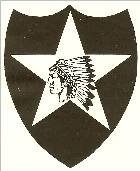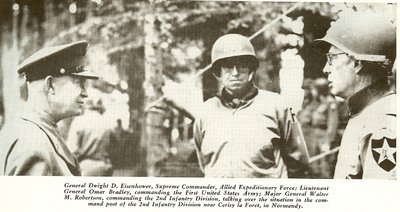
Following the Trevieres engagement, the battalion was placed in reserve; it moved up to Cerisy-la-Foret through the desolation of shattered enemy vehicles and dead.
Opposition on this move was chiefly confined to harassing snipers, a hazard throughout the Normandy campaign for the wooded thickets were well suited to the camouflaged hidden enemy. Here at Cerisy the battalion set up an all around defensive position; the town was to be held at all costs. It lay on the path to the strategic St. Lo toward which we were steadily forging. Cerisy will always be remembered as the place where the battalion learned what tragedies can grow out of “trigger happiness”; where rumors were rampant; where a false alarm as attack caused much initial anxiety and later drew many laughs; where Company “H” alone overcame a mythical counter-attack; where Captain Martin and 1st Sgt Illi, became casualties when diving for the same fox-hole, which turned out to be only a shadow; where Lt Farell began his one man crusade against the Wehrmacht; and where Col Norris emptied a grease gun into a dummy door. The reserve period was short of duration; at 0330 hours June 13 the order came down that the battalion was to attack the high ground approximately eight miles northeast of St. Lo which had originally been attempted by the 23rd Infantry Regiment.

The attack was swift; what enemy resistance was encountered were swiftly overrun in short bitter contests; by 2010 hours that night, operations had covered approximately six miles over a terrain of rolling hills and small wooded thickets to within a mile and a half northwest of St. George D’Elle. During this attack, Major Barsanti left the battalion to take over the command of the third battalion whose command officer was killed in action. Captain Martin became the Executive Officer of the battalion and Lieutenant Farrell, the commanding officer of Company “H”.
The next two days saw activity in the battalion sector confined to improvement of defensive positions, reconnaissance and patrolling. However, this brief defensive period was highlighted by the slaughter of a platoon of “Krauts” in column who unwittingly walked into the line of fire of one of our 57’s, three MG, and out 81’s. At 2050 hours, June 15, Regiment sent down the attack order. The 38th Infantry regiment was to attack and take as its objective the ground north of the main road to St. Lo; the specific tasks of this battalion was to seize the right portion of the high round and more high ground to the southwest. The attack opened the next morning at 0800 hours with an intensive artillery barrage rained down upon the enemy.
From the start, enemy resistance was very fierce and throughout the battle a constant barrage of artillery and mortar fire was laid down on the assault companies. Advance was slow; the terrain was extremely difficult being heavily wooded, and cut with hedgerows which bounded all fields. Nonetheless, against most determined resistance, the battalion did advance until it reached their “Phase Line Road”, a road running midway between Le Parc and La Giffardiere. Beyond this it could not go; the enemy was too strongly entrenched on the hill ahead and our attacks were hurled back with utmost ferocity by heavy automatic fire and concentrated artillery and mortar shelling. Company “F” did manage to secure a forward position across the road but it was ordered back prior to darkness so that the battalion could effectively batten up for the night. This June 15 was one of the most disastrous for the battalion.
Although we did reach our objective as planned, we suffered extremely heavy casualties – close to 100 officers and men killed and wounded with Company “G” suffering the greatest share. (Author Note: my father was a Platoon Sergeant in Company G)
On this day Capt Raymond and Capt Manuel were seriously wounded, and Staff Sergeant Ortell, a veteran of World War I was killed.
No, our initial objective had not been taken, but this is understandable now in the light of what we know of the extreme importance of St. Lo to the enemy defense in fighting which would enable our tanks to break into the network of roads and envelope the country in all directions. First Lieutenant Farrell became the Battalion Operations Officer and the Command of Company “H went to First Lieutenant Michael J. Wichrowski, and that of Company “G” to 1st LT Werner. The battalion command post was set up at La Griffardiere. The days that followed up to June 27 saw effort concentrated on extensive patrolling, day and night, with bitter fighting on a contact with the enemy; it was a hazardous business with enemy always on the alert, and who, at the same time, continued to send down a constant harassing mortar fire on our positions. In this interim, the Regiment gained a new commander, Colonel Ralph W. Zwicker who succeeded Colonel Walter H. Elliott.
On June 27 the battalion went into a reserve position at La Vielle until July 3. During this period the Battalion practices Tank Infantry coordination in preparation for the attack on Hill 192, rested, replaced equipment, reorganized, and conducted schools, so as to profit by the experience to date.
It was also during this rest period that Capt Wallace, while taking his first bath in three weeks, was chased out of his private pool by a most untimely artillery concentration.
On July 1, the battalion received a commendation from Major General Walter M. Robertson, Division Commander, for “the superior performance of duty under difficult conditions during the occasion of its first combat period from 9 June 1944 to 10 June 1944 in the vicinity of Trevieres, France.”
Next: Chapter II and the Battle for Hill 192

![]()
ATTENTION READERS
We See The World From All Sides and Want YOU To Be Fully InformedIn fact, intentional disinformation is a disgraceful scourge in media today. So to assuage any possible errant incorrect information posted herein, we strongly encourage you to seek corroboration from other non-VT sources before forming an educated opinion.
About VT - Policies & Disclosures - Comment Policy



